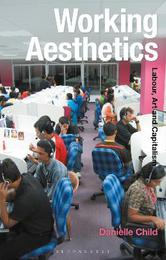
|
Working Aesthetics: Labour, Art and Capitalism
Hardback
Main Details
Description
Working Aesthetics is about the relationship between art and work under contemporary capitalism. Whilst labour used to be regarded as an unattractive subject for art, the proximity of work to everyday life has subsequently narrowed the gap between work and art. The artist is no longer considered apart from the economic, but is heralded as an example of how to work in neoliberal management textbooks. As work and life become obscured within the contemporary period, this book asks how artistic practice is affected, including those who labour for artists. Through a series of case studies, Working Aesthetics critically examines the moments in which labour and art intersect under capitalism. When did labour disappear from art production, or accounts of art history? Can we consider the dematerialization of art in the 1960s in relation to the deskilling of work? And how has neoliberal management theory adopting the artist as model worker affected artistic practices in the 21st century? With the narrowing of work and art visible in galleries and art discourse today, Working Aesthetics takes a step back to ask why labour has become a valid subject for contemporary art, and explores what this means for aesthetic culture today.
Author Biography
Danielle Child is Lecturer in Art History at Manchester School of Art, Manchester Metropolitan University, Culture Editor for Red Pepper magazine and a member of the Association of Art Historians.
ReviewsThe book offers not only well-documented analysis of artistic practices, but also an enlightening journey through the major sociological, philosophical and political texts that have renewed the understanding of capitalism in recent decades. * Critique d'art (Bloomsbury translation) * Child's contribution to the ongoing debate on art's relationship to work is vitally important and distinctive. Focusing on case studies, Child demonstrates that art's autonomy has a porous relationship to capitalist patterns of labour. This book is particularly valuable because it does not restrict the examination of artistic labour to the activities of the artist as author, thinker or maker but provides a detailed analysis of the displacement of the artist in the production of artworks by acknowledged and unacknowledged fabricators, participants and assistants both paid and unpaid. * Dave Beech, Professor of Art, Valand Academy and the University of the Arts London, UK * With smartly chosen case studies and sharply written analysis, Danielle Child has contributed enormously to conversations about capitalism and artistic labor, examining not only historical models but also speculating about the future for art workers of all kinds, including fabricators, assistants, and even audiences. * Julia Bryan-Wilson, Professor of Modern and Contemporary Art, University of California, Berkeley, USA * A milestone in re-reading contemporary art history through the optics of labour power and industrial production, proposing that the rapid changes in immaterial and affective labour in late consumer capitalism establish the artist and art worker as, potentially, paradigmatic neoliberal worker. A highly absorbing, forensic account structured around case studies which take us from the deskilled assembly lines of Ford Motor Company to the call centres of Calcutta, from the YBA's art fabricators to community projects in the Bronx, and from Marx and his many contemporary exponents to anti-corporate performance activists. The unexpected and illuminating reversals of the accepted standards of art history and criticism are both intuitive and unsparing, revelatory and self-evident, yet never losing from sight an unprecedented potential to remain engaged and active in the political field. Working Aesthetics belongs to those most significant of critical works which pull no punches, explicitly re-draw the map, and ask, as both Laurie Anderson and Toto the dog have decades apart, that crucial question: 'What is behind that curtain?' -- Phil Collins, artist and filmmaker, Professor of Video Art and Performance, Academy of Media Arts Cologne, Germany
|